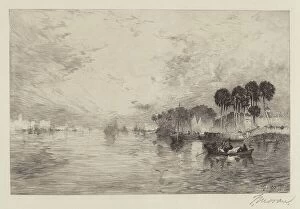Etching And Drypoint In Black Collection
"Etching and Drypoint in Black: Exploring the Artistry of Whistler and Hassam" Step into the captivating world of etching and drypoint
For sale as Licensed Images
Choose your image, Select your licence and Download the media
"Etching and Drypoint in Black: Exploring the Artistry of Whistler and Hassam" Step into the captivating world of etching and drypoint, as we delve into the masterpieces created by James Abbott McNeill Whistler and Frederick Childe Hassam. These renowned artists have left an indelible mark on the art world with their exceptional talent for capturing scenes in black ink. In Billingsgate, 1859, Whistler takes us back to a bustling London fish market, where intricate details come alive through his meticulous etching technique. Rotherhithe, 1860 transports us to a serene riverside scene, showcasing Whistler's ability to evoke tranquility through delicate lines. The Tiny Pool, 1876/1878 reveals Whistler's mastery of drypoint as he portrays a peaceful pond surrounded by lush vegetation. Meanwhile, The Lime-Burner from 1859 captures the gritty industrial landscape with remarkable precision. Whistler's Thames Police from 1859 showcases his unique ability to infuse drama into everyday life along the riverbanks. Moving forward in time, Portsmouth Doorway by Hassam in 1916 offers a glimpse into architectural beauty rendered through expertly executed etchings. Hassam's A Vermont Village in 1923 brings forth rustic charm with its picturesque depiction of rural life. Fulham from 1878/1879 highlights Whistler's versatility as he effortlessly transitions between different subjects - this time portraying urban scenery bathed in darkness. The Adam and Eve at Old Chelsea appears twice on our list - once from Whistler in 1878 and again later that year. These pieces showcase his fascination with depicting atmospheric night scenes using drypoint techniques. Through these exquisite works of art created using etching and drypoint methods, both artists transport us across time periods and locations. Each stroke tells a story; each line captures a moment frozen in time.












